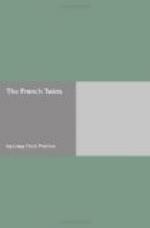In providing adequate background for the story, the teacher will find fertile resources in newspapers and magazines. The Red Cross Magazine, The National Geographic Magazine, the Boy Scout and the Girl Scout publications, are readily accessible and contain much valuable supplementary material for classroom use. The Foreign Legion, the Battles of the Marne, Joffre’s visit to the United States, Rheims Cathedral, important events near the scenes of the story, etc., can be made clear and real to the children by the aid of maps, illustrations, and articles in these magazines, and by means of picture post-cards, and other material from other sources. The story of the founding of the Red Cross, the origin of its flag, etc., will help to vivify the incidents connected with this organization.
As for French history, the two focus points are the stoniest of Joan of Arc and Bastille Day. Both furnish abundance of colorful detail and incident upon which to build the pupils’ conceptions of the spirit and ideals of the French people. In the case of Bastille Day, correlation should be made between that day and our own Independence Day, comparing the French and American Revolutions and indicating the similar circumstances in the two movements. Lafayette’s part in our War of the Revolution and America’s payment of our debt to France in the Great War form another means of making familiar to the children the story of our historic friendship with France.
While The French Twins is a war story, soldiers and trenches and battle-fields are nevertheless not the main features; on the contrary, The French Twins depicts the necessary part played by women, children, and old people during the War, and shows how the spirit and aims of the soldiers’ families have been the same as those of the soldiers themselves. Self-control, endurance, and cheerfulness at home are proved to be as much a part of true bravery as fearlessness in battle. Since the soldier’s part in the War has been held closely to everyone’s attention, the reading of this story will supply a balancing view of the other side of war; and the pupils’ perspective of the whole cannot fail to gain in scope.
Books which may be commended to the teacher, for descriptions of various aspects of the Great War, are: Hay’s The First Hundred Thousand; Nicolas’s Campaign Diary of a French Officer; Aldrich’s A Hilltop on the Marne; Hall’s High Adventure and Kitcheners Mob; Buswell’s Ambulance No. 10; Haigh’s Life in a Tank; Stevenson’s From “Poilu” to “Yank"; two anonymous books, The Retreat from Mons and Friends of France; Paine’s The Fighting Fleets; and Root and Crocker’s Over Periscope Pond.
For children’s reading, we suggest Mrs. Perkins’s The Belgian Twins, Sara Cone Bryant’s I am an American, Thwaites and Kendall’s History of the United States, Tappan’s Little Book of the War, and such compilations as Stories of Patriotism and The Patriotic Reader.




